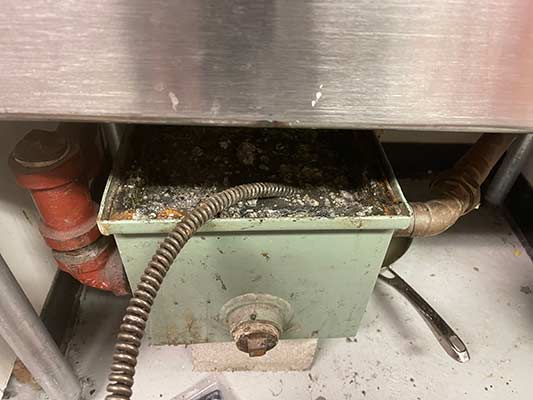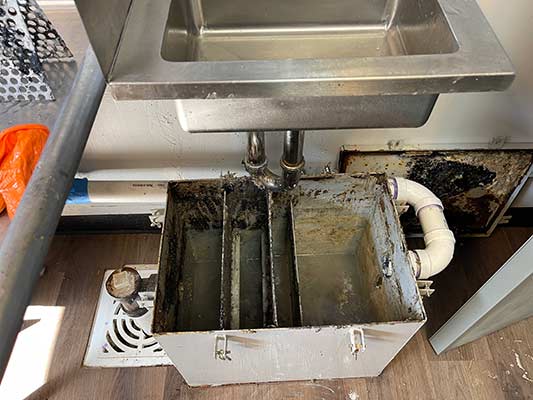
Grease traps are an essential component of any commercial kitchen or food service establishment. They help prevent grease, oils, and fats from entering the wastewater system and causing blockages. However, over time, grease traps can become clogged and ineffective if not properly maintained. Here we will guide you through the process of unclogging a grease trap, ensuring your kitchen operates smoothly and efficiently.
Understanding Grease Traps
Before we dive into the unclogging process, let’s first understand what a grease trap is and how it works. A grease trap, also known as a grease interceptor, is a plumbing device that captures and separates fats, oils, and greases (FOGs) from wastewater. The trapped FOGs rise to the top, while the clarified wastewater flows out through an outlet pipe.
Grease traps are typically installed in commercial kitchens, restaurants, cafeterias, and other food service establishments. The accumulation of FOGs in the grease trap can eventually lead to clogs, causing unpleasant odors, drainage issues, and potential damage to your plumbing system. Regular maintenance and occasional unclogging are necessary to keep your trap functioning optimally.
Signs of a Clogged Grease Trap
Identifying a clogged grease trap is crucial to prevent further problems in your kitchen. Here are a few common signs that indicate your trap might be clogged:
- Slow drainage: If your sinks, dishwashers, or other plumbing fixtures are draining slowly, it could be a sign of a clogged trap.
- Unpleasant odors: Foul smells coming from the sink or floor drain can be a result of accumulated FOGs in the grease trap.
- Water pooling: If you notice that water is pooling around your sink or other plumbing fixtures, it could be a sign of a clogged trap.
- Backups or overflows: When the trap is severely clogged, it might cause backups or overflows in your plumbing system.
If you notice any of these signs, it is essential to take immediate action to unclog and cleanout your commercial grease trap and prevent further complications.
Tools and Materials Required
Before you start the unclogging process, it’s necessary to gather the right tools and materials. Here’s what you’ll need:
- Safety gloves
- Safety goggles
- Rubber scraper or spatula
- Bucket or container
- Plunger
- Plumbing snake or auger
- Hot water
- Baking soda
- Vinegar
Step-by-Step Guide to Unclog a Grease Trap
Now that you have everything you need, let’s proceed with the step-by-step process of unclogging a grease trap:
Step 1: Safety First
Before you begin, make sure to wear safety gloves and goggles to protect yourself from any potential splashes or fumes.
Step 2: Remove Grease from the Surface
Using a rubber scraper or spatula, carefully remove any visible grease or solidified fats from the surface of the trap. Place them in a bucket or container for disposal.
Step 3: Plunge the Drain
If the grease trap is only partially clogged, you can try using a plunger to clear the blockage. Fill the sink or fixture with enough water to cover the plunger, and create a tight seal around the drain opening. Plunge vigorously up and down for about a minute to dislodge the clog.
Step 4: Use a Plumbing Snake or Auger
If plunging doesn’t solve the issue, you may need to use a plumbing snake or auger. Insert the snake or auger into the drain pipe leading to the trap and rotate it clockwise as you push it down. This will help break up and remove any stubborn clogs. Continue feeding the snake until you feel resistance, then rotate it again to break up the clog further. Finally, slowly pull the snake back out, removing any debris or blockages along the way.
Step 5: Flush with Hot Water
After using the plunger or plumbing snake, it’s essential to flush the trap with hot water. Boil a large pot of water and carefully pour it down the drain to help dissolve any remaining fats or greases. The hot water will help flush out the loosened clog and clear the pipes.
Step 6: Use Baking Soda and Vinegar
If the trap is still experiencing drainage issues, you can try using a natural solution made with baking soda and vinegar. Start by pouring half a cup of baking soda down the drain, followed by one cup of vinegar. The chemical reaction between the two will create a foaming effect, helping to break down any residual grease or fats. Let the mixture sit for about 30 minutes, then flush with hot water.

Unclogging a grease trap is an essential task for maintaining the efficiency and functionality of your commercial kitchen or food service establishment.
Maintaining a Healthy Grease Trap
Prevention is always better than the cure when it comes to grease trap clogs. Here are some tips to keep your grease trap running smoothly:
- Frequent cleaning: Regularly scrape off any excess grease or fats from the surface of the trap and dispose of them properly.
- Proper waste disposal: Avoid pouring cooking oils, fats, or greases down the sink. Instead, collect them in a separate container and dispose of them in the appropriate waste bin.
- Regular professional maintenance: Schedule routine inspections and maintenance with a professional plumber to ensure your grease trap remains in optimal condition.
- Install a grease trap alarm: Consider installing a grease trap alarm that can alert you when the grease levels are reaching capacity, allowing you to take timely action before a clog occurs.
In Conclusion
Unclogging a grease trap is an essential task for maintaining the efficiency and functionality of your commercial kitchen or food service establishment. By following the step-by-step guide provided in this article, you can effectively unclog your trap and prevent future blockages. Remember to prioritize safety, gather the necessary tools and materials, and consider implementing preventive measures to maintain a healthy grease trap. With regular maintenance and proper waste disposal practices, you can ensure a smooth and uninterrupted operation in your kitchen.